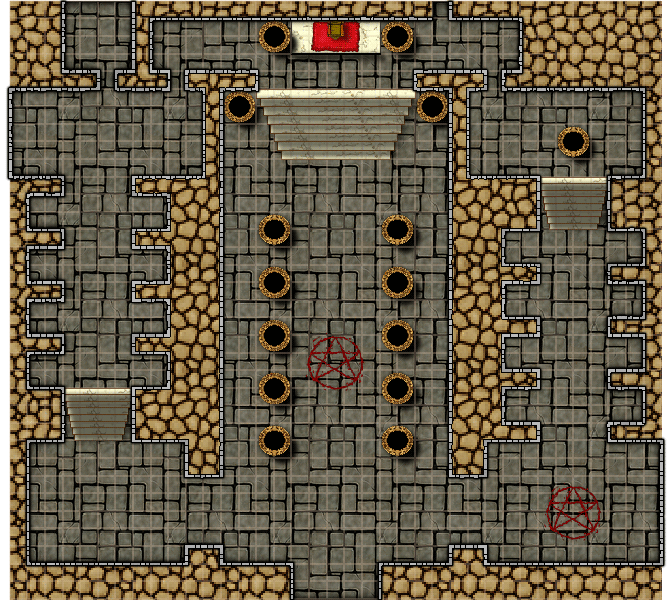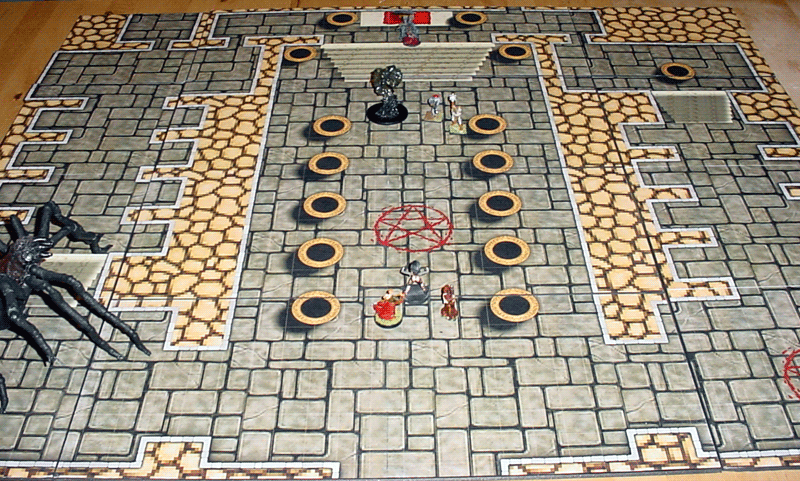Here's one of the maps I created for an RPGA Adventure during the Dungeons & Dragons Experience (DDXP). This is based on the map that was provided for the adventure COR8-03 Aspirations and served as the throne room for a goblin king.

This is the battle map being used in actual play:

Comments
Here are pictures of the actual printed and built terrain in action:
--Dale--
Ahh, I am also looking forward to the eventual Dioramas3 update (with all new artwork). Perhaps it will be the next one on the list (after CD3 that is!)
(I'm just joking! That is an unbelievable map--I had some players ask me why I don't do maps like this--and I said I don't like them that much.)
Yeah, I do have a pretty awesome group and they get all excited when we have battles in these funky settings. So I like doing these kinds of things for them. It makes the combats more exciting than my drawings on the old Chessex battlemat. The 2d maps get used much more often, but the lava chamber was just an idea run amok. The funny thing is that the 3d map was actually less work to create, print, assemble and light. The 2d map was slightly more painful to create.
Some places in the US also sell Mardi Gras lights just before Mardi Gras. Gold, Blue, and green are the colors.
@ShadoWWW: In theory you should already be able to achieve things like this with Dioramas Pro in CC3 using bitmap fills instead of Dioramas own fills.
I to am an RPGA judge and I am looking at CC3 and DD3 to make maps for the new Living Forgotten Realms modules. Do you have any thoughts on how well the Dungeon Tile maps translate over into CC3?
BTW, hope to see you at this year's DDXP. I will be one of Dave Christ's minions there.
I'm currently working on the maps for The Black Knight of Arabel, an LFR adventure. The maps there do use Dungeon Tiles, but it is not in any way restricting my mapping with CC3/DD3. I've noticed that the maps I make with CC3 look much better because they are more closely "themed". With Dungeon Tiles sometimes the maps look weird because the tiles do not look like they belong together.
Hope that helps, and keep on mapping.
The Road to Arabel
The Dark Rider's Haunt
Theater
Road to somewhere
Foreboding Cave Entrance.
These maps are for use with the RPGA Adventure Gangs of Wheloon. I will add more of them and possibly some pictures from the actual game when I have an opportunity.
City Courtyard
Gang's Hideout
So when making maps for a tabletop campaign...
What do you feel is the best method of printing out, say, a dungeon crawl map? I am trying to find a way which allows me to print out nice battlemaps, but also allows me to keep what's just around the corner (that of the dungeon which they haven't discovered yet) and hidden things out of their view. Ideally, of course, with the ability to reveal these things as they discover them. The only thing that I have come up with is multiple printings of the same maps, and adding tiles as they progress or discover things. I only don't like it because I feel that it may tip them off sometimes, and it also seems a waste of paper and ink.
Any suggestions?
goldgrae, as for your question, it depends. When printing I usually print the map in sections (8.5" x 11") and then assemble it into a complete map (usually 24" x 36"). There have been many times that having the complete map pre-constructed was more important than the "surprise" factor. So in most of my games I'll assemble the complete map to save time. Then I'll take blank cardstock and place it over the parts that they have not visited.
I tried the "assemble as they go" method, but it became too cumbersome and we lost too much momentum. Not as much as having to draw the map by hand but not as fast as just flipping a piece of blank cardboard off the map. I find that having the whole thing preassembled saves a lot of time and keeps the game pace fast.
In terms of CC3/DD3, what size map yields a 24x36 inch (where an inch is five feet in scale)? I suppose, really, that any size map of that proportion would work. Any suggestions on what works best, though?
A 24" x 36" map is very large. It is comparable to a complete Chessex BattleMat in size. For scale you are talking about something that is 120' wide x 180' long. In dungeon terms that is pretty big. I usually end up making two maps fit in an area that size. If you look at the maps above, you could fit 2 of the "Foreboding Cave Entrance" maps side by side on a 24 x 36 map.
Yeah, I just figured that I could adjust the size and therefore the scale as necessary once I had a good base to work from, that's all.
Maybe I could use label sheets and then just stick down the secret once they find it. While it might not work very well for hidden rooms in and of themselves, it could be used for sprung traps, secret doors, etc. Probably a pretty limited application, though.
No reason, of course, that I can't just tell them verbally.